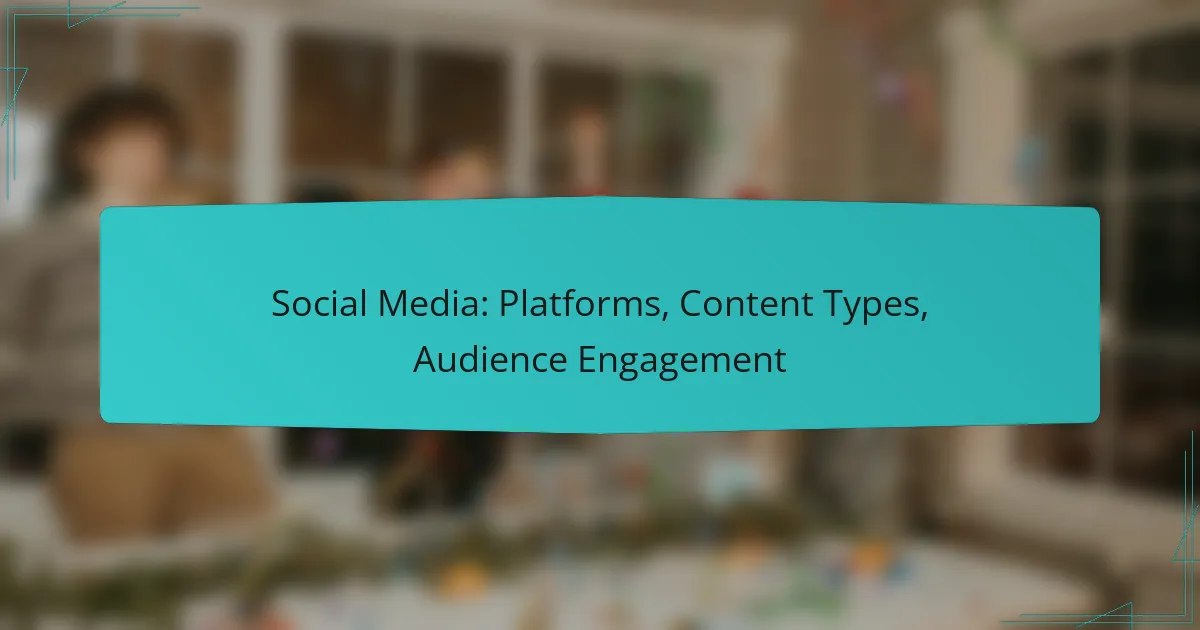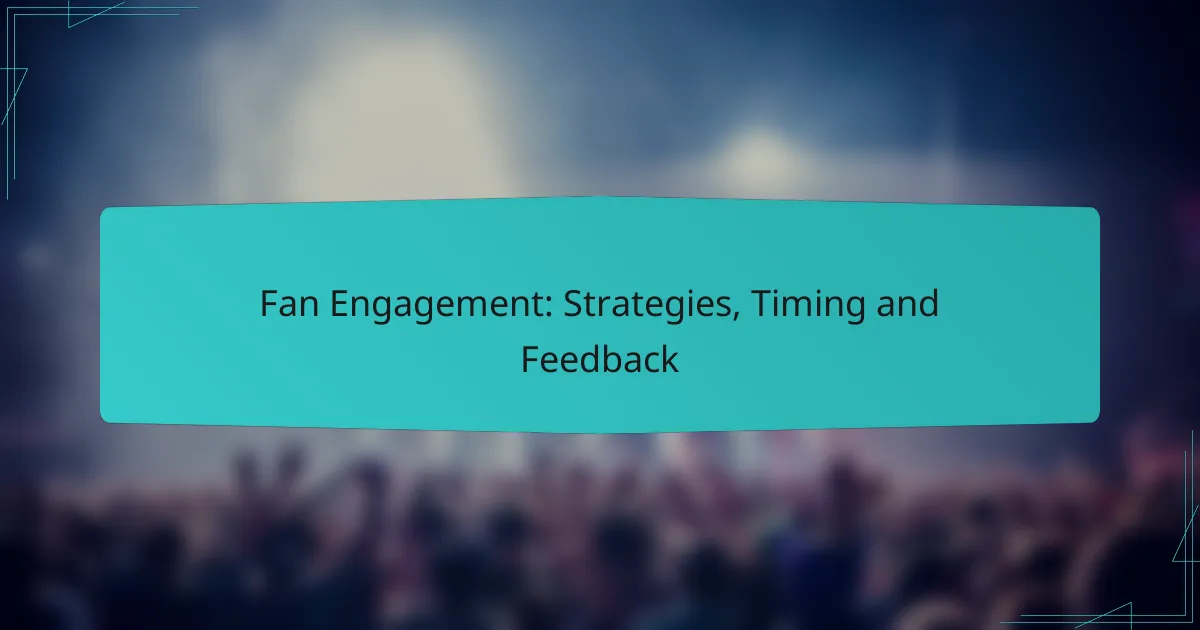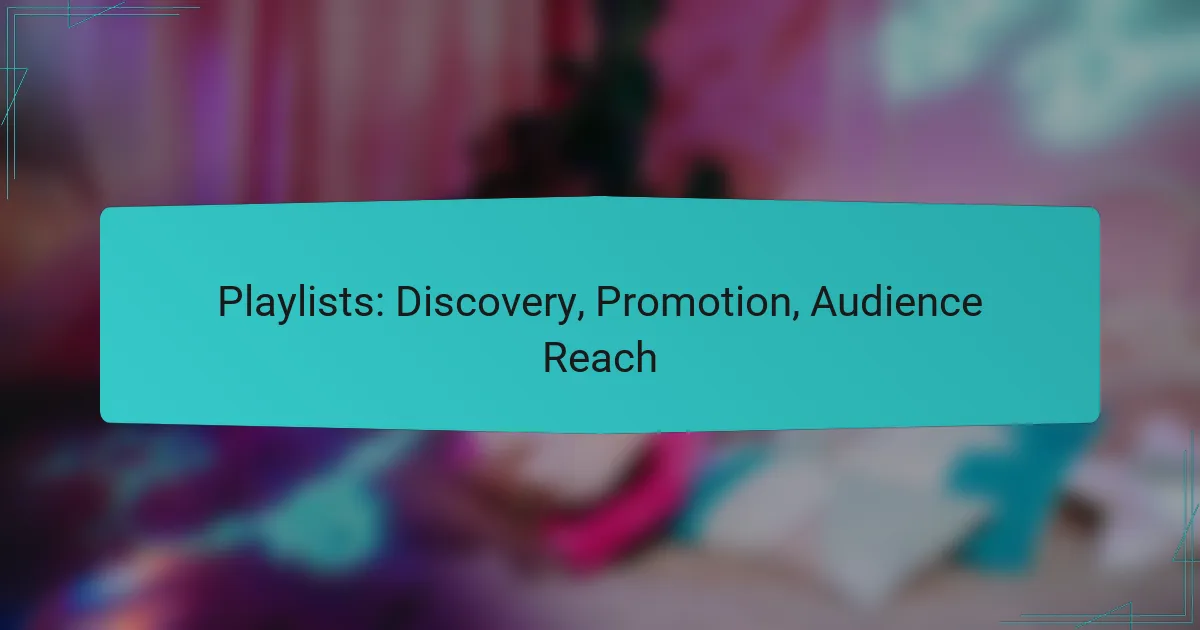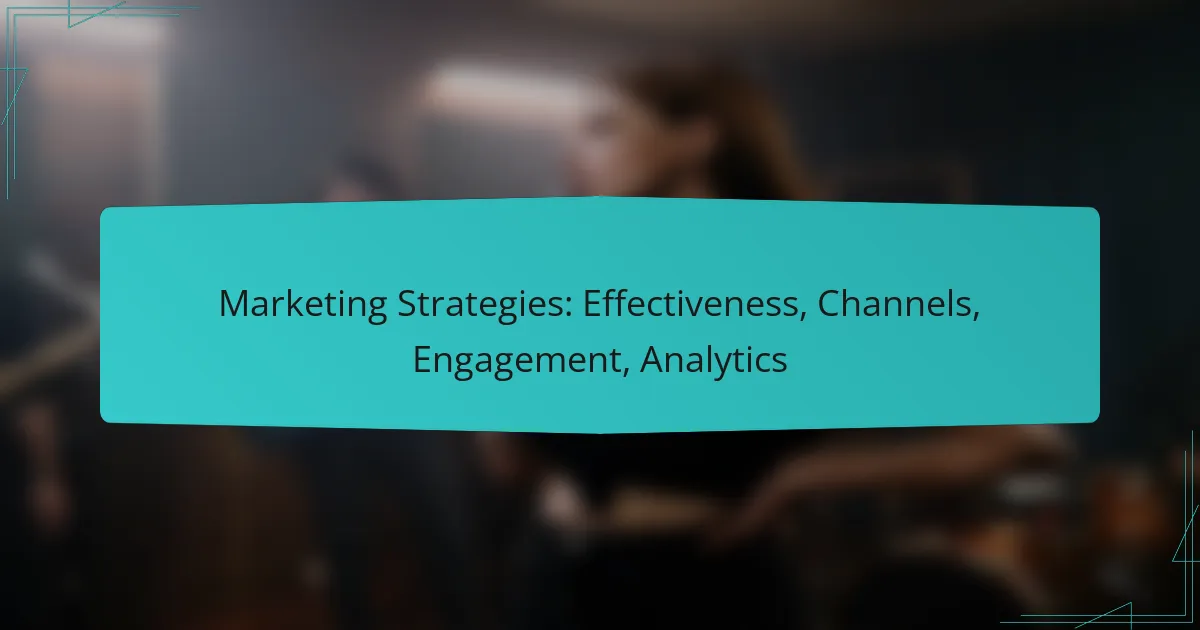Social media has become an essential tool for connecting with audiences and promoting digital products across various platforms like Facebook, Instagram, LinkedIn, Twitter, and TikTok. Each platform offers distinct features that can enhance audience engagement through tailored content types, such as visuals and storytelling. By implementing interactive strategies like live Q&A sessions and contests, brands can foster a sense of community and encourage active participation from their followers.

Which social media platforms are most effective for digital products?
Effective social media platforms for digital products include Facebook, Instagram, LinkedIn, Twitter, and TikTok. Each platform offers unique features that cater to different audience engagement strategies and content types.
Facebook for targeted advertising
Facebook is renowned for its targeted advertising capabilities, allowing businesses to reach specific demographics based on interests, behaviors, and location. This precision helps optimize ad spend and improve conversion rates.
Utilizing Facebook Ads Manager, you can create campaigns that target users with particular characteristics, such as age, gender, and purchasing habits. A/B testing different ad formats can further enhance effectiveness.
Instagram for visual storytelling
Instagram excels in visual storytelling, making it ideal for brands that rely on aesthetics to attract customers. High-quality images and engaging videos can showcase digital products effectively, capturing audience attention.
Utilizing features like Stories, Reels, and IGTV can enhance engagement. Brands should maintain a consistent visual style and use relevant hashtags to increase visibility and reach.
LinkedIn for B2B engagement
LinkedIn is the go-to platform for B2B engagement, connecting professionals and businesses. It’s particularly effective for promoting digital products that cater to industry-specific needs.
Sharing insightful articles, case studies, and white papers can establish authority and foster connections. Participating in relevant groups and discussions can also enhance visibility among potential clients.
Twitter for real-time updates
Twitter is ideal for real-time updates and engaging with audiences through concise messaging. Its fast-paced nature allows brands to share news, promotions, and customer interactions instantly.
Utilizing trending hashtags can increase the reach of your tweets. Engaging with followers through replies and retweets can build community and enhance brand loyalty.
TikTok for viral content
TikTok is a powerful platform for creating viral content, especially among younger audiences. Short, engaging videos can quickly capture attention and promote digital products in a fun and relatable way.
Brands should focus on creativity and authenticity, using popular trends and challenges to enhance visibility. Collaborating with influencers can also amplify reach and engagement.
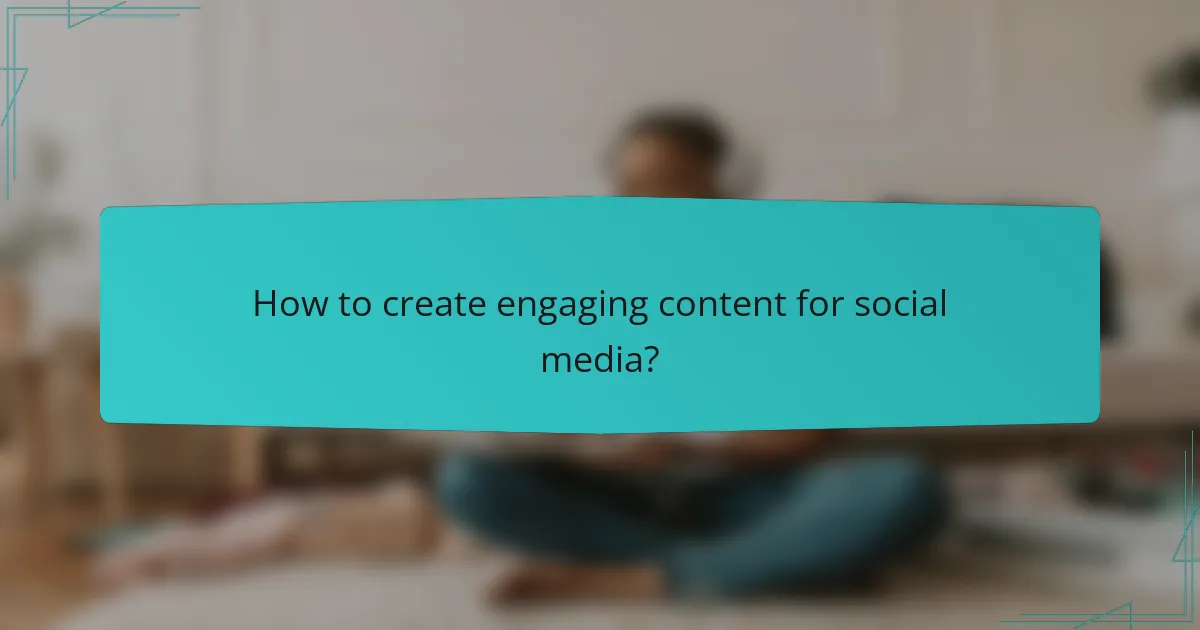
How to create engaging content for social media?
Creating engaging content for social media involves crafting posts that capture attention and encourage interaction. Focus on visuals, storytelling, and user involvement to enhance audience connection and retention.
Use high-quality visuals
High-quality visuals are essential for grabbing attention on social media. Use clear images, vibrant colors, and appealing designs to make your content stand out in crowded feeds.
Consider using tools like Canva or Adobe Spark to create professional-looking graphics. Aim for a resolution of at least 1080 x 1080 pixels for images to ensure clarity across platforms.
Incorporate storytelling techniques
Storytelling can make your content more relatable and memorable. Share personal anecdotes, customer stories, or brand narratives that resonate with your audience’s experiences.
Use a clear structure: introduce a conflict, build tension, and conclude with a resolution. This approach keeps viewers engaged and encourages them to share your content.
Leverage user-generated content
User-generated content (UGC) helps build community and trust. Encourage your audience to share their own experiences with your brand, which you can then repost or feature.
Consider running contests or campaigns that invite users to submit photos or testimonials. This not only provides authentic content but also fosters a sense of belonging among your followers.
Utilize interactive elements
Interactive elements, such as polls, quizzes, and questions, can significantly boost engagement. These features invite your audience to participate actively rather than passively consuming content.
Platforms like Instagram and Facebook offer built-in tools for creating polls and quizzes. Aim to include at least one interactive post per week to maintain audience interest and encourage feedback.
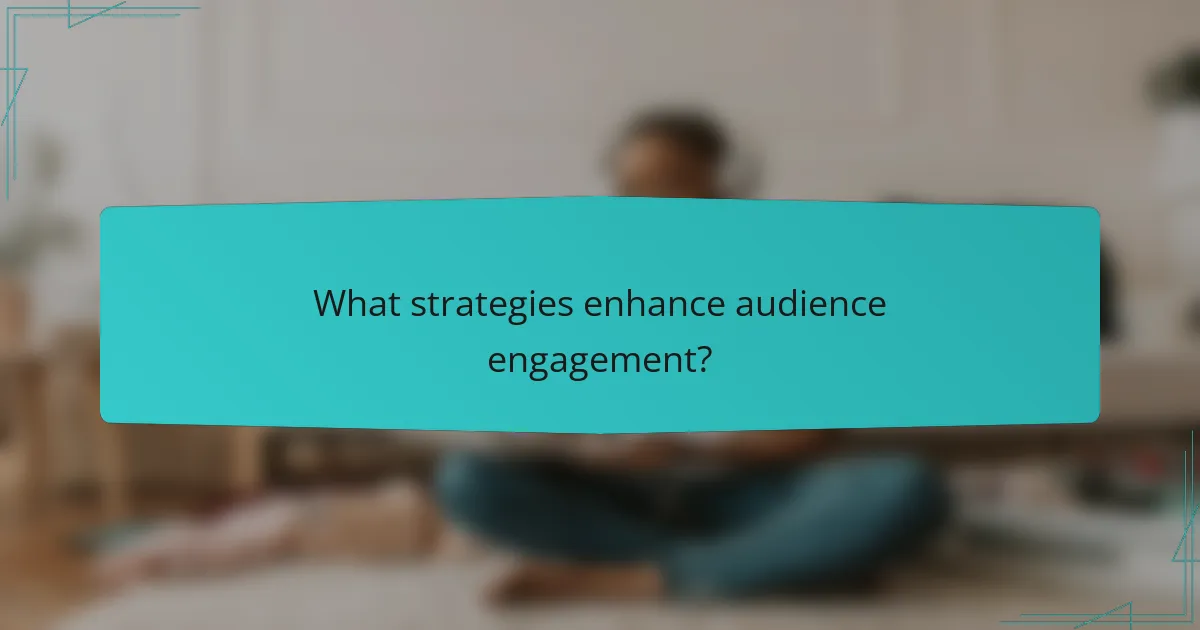
What strategies enhance audience engagement?
Effective audience engagement strategies include hosting live Q&A sessions, running contests and giveaways, responding promptly to comments, and utilizing polls and surveys. These methods foster interaction, build community, and encourage active participation from followers.
Host live Q&A sessions
Live Q&A sessions allow audiences to interact directly with brands or influencers in real-time. This format creates a sense of immediacy and personal connection, making participants feel valued and heard.
To maximize engagement, promote the session in advance across your social media platforms. Consider using platforms like Instagram Live or Facebook Live, which are popular for their interactive features.
Run contests and giveaways
Contests and giveaways can significantly boost audience engagement by incentivizing participation. These activities encourage users to share content, tag friends, or follow your account, which can increase visibility and reach.
When planning a contest, clearly outline the rules and ensure the prizes are relevant to your audience. For example, a beauty brand might offer a product bundle, while a tech company could provide the latest gadget.
Respond promptly to comments
Timely responses to comments show your audience that you value their input and are actively listening. This practice can enhance loyalty and encourage more users to engage with your content.
Set a goal for response times, such as replying within a few hours. Use tools like social media management platforms to streamline this process and ensure no comment goes unnoticed.
Utilize polls and surveys
Polls and surveys are effective tools for gathering audience feedback and insights. They not only engage users but also provide valuable data that can inform your content strategy.
Platforms like Twitter and Instagram offer built-in polling features that make it easy to ask questions. Keep polls short and relevant, and consider sharing the results to show your audience that their opinions matter.

What metrics should you track for social media success?
To measure social media success, focus on key metrics that reflect engagement, conversion, and growth. Tracking these metrics helps you understand audience behavior and optimize your content strategy.
Engagement rate
Engagement rate measures how actively your audience interacts with your content, typically calculated as the total interactions (likes, comments, shares) divided by total followers or impressions. A higher engagement rate indicates that your content resonates well with your audience.
To improve your engagement rate, post content that encourages interaction, such as polls or questions. Aim for engagement rates above 1-3% for most platforms, but remember that benchmarks can vary by industry.
Conversion rate
Conversion rate tracks the percentage of users who take a desired action, such as making a purchase or signing up for a newsletter, after engaging with your social media content. This metric is crucial for assessing the effectiveness of your campaigns.
To calculate conversion rate, divide the number of conversions by the total number of visitors from social media, then multiply by 100. A good conversion rate typically ranges from 2-5%, depending on the industry and platform.
Follower growth
Follower growth measures the increase in your social media audience over a specific period. This metric indicates the effectiveness of your content in attracting new users and retaining existing ones.
Monitor follower growth monthly to identify trends and adjust your strategy accordingly. Aim for a steady growth rate of 5-10% per month, but be cautious of sudden spikes, which may indicate bot activity.
Reach and impressions
Reach refers to the total number of unique users who see your content, while impressions count how many times your content is displayed, regardless of whether it was clicked. Both metrics help gauge the visibility of your posts.
To maximize reach and impressions, consider using paid promotions or collaborating with influencers. Aiming for a reach that exceeds your follower count indicates effective content distribution and audience interest.
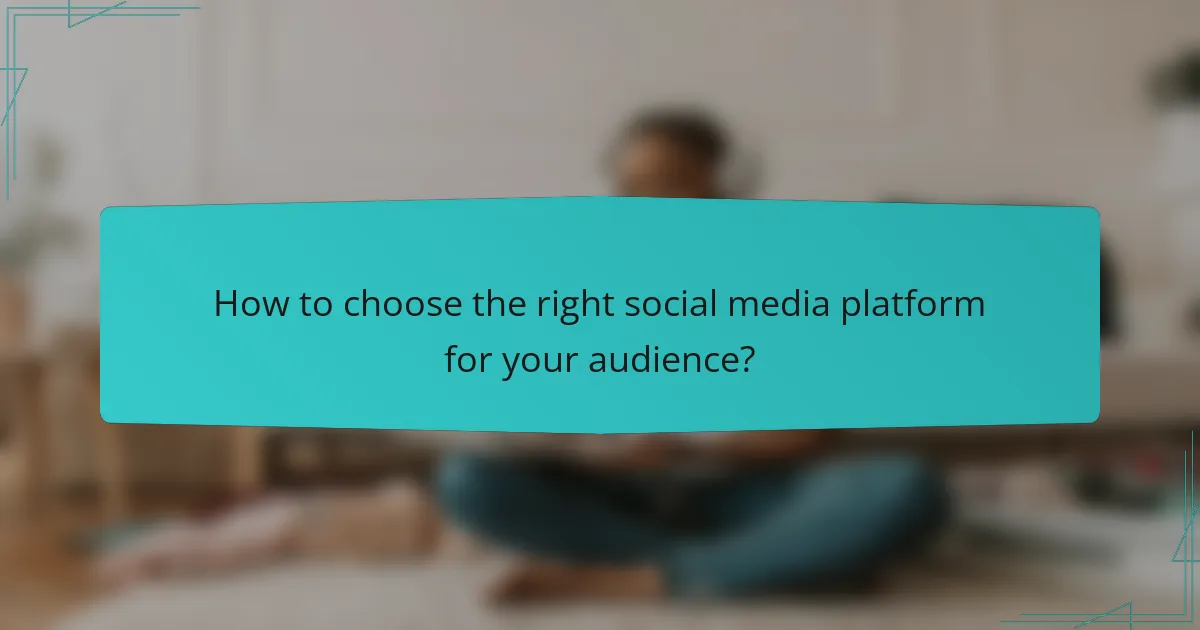
How to choose the right social media platform for your audience?
Choosing the right social media platform involves understanding where your target audience spends their time and what type of content they prefer. Each platform has unique characteristics that cater to different demographics and content formats, so aligning your strategy with your audience’s preferences is crucial.
Understand your audience demographics
Start by researching the demographics of your target audience, including age, gender, location, and interests. Platforms like Facebook and Instagram tend to attract a broader audience, while TikTok and Snapchat are popular among younger users. Knowing these details helps you select platforms that align with your audience’s characteristics.
Utilize tools like Google Analytics and social media insights to gather data on your existing audience. This information can guide your decision-making process and help you identify gaps in your current social media strategy.
Evaluate content types and formats
Different social media platforms support various content types, such as images, videos, and text. For instance, Instagram is highly visual, making it ideal for brands that can leverage striking imagery, while Twitter is better suited for concise text updates and real-time engagement. Assess your content capabilities to ensure they match the platform’s strengths.
Consider experimenting with multiple formats, such as live videos on Facebook or short clips on TikTok, to see what resonates best with your audience. This trial-and-error approach can help refine your content strategy over time.
Assess engagement and interaction levels
Engagement levels vary significantly across platforms. For example, LinkedIn is often used for professional networking and may yield higher engagement for B2B content, while platforms like Instagram and TikTok can drive more casual interactions. Understanding these dynamics can help you choose a platform that fosters the type of engagement you seek.
Monitor how your audience interacts with your content on different platforms. High engagement rates can indicate a strong fit, while low interaction may suggest a need to reassess your platform choice or content strategy.
Consider advertising options and costs
Each social media platform offers different advertising options and costs, which can impact your overall marketing budget. Facebook and Instagram provide robust advertising tools with detailed targeting options, while platforms like TikTok are emerging with unique ad formats that appeal to younger audiences. Evaluate your budget and advertising goals to determine the most cost-effective platforms.
Be aware of potential costs associated with each platform, including ad spend and content creation expenses. Setting a clear budget can help you allocate resources effectively and maximize your return on investment.
